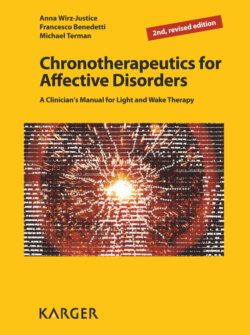Читать книгу Chronotherapeutics for Affective Disorders - M. Terman - Страница 15
На сайте Литреса книга снята с продажи.
1.5 Mood Level Varies with Time of Day and Duration of Wakefulness
ОглавлениеThe two-process model has been able to explain much of the physiology of sleep and wakefulness, as well as aberrant sleep-wake cycle behaviour. Beyond sleepiness per se, it is surprising to see that interactions of process C and process S also regulate daily cycles of mood (clinically seen as diurnal variation) [22]. Mood follows the circadian rhythm of core body temperature rather clearly. Figure 9 represents the two processes in healthy subjects, as educed components derived from a laboratory protocol [22]. Process C begins with lowest mood in the early morning, improving throughout the day with best mood in the evening, followed by a decline during the night. Process S-related mood is at its best when sleep pressure is low after awakening, and thereafter declines the longer we are awake. Normal, stable mood regulation during the day requires good temporal alignment between the sleep-wake cycle and the circadian system, so that there are no low points. By superposing and shifting these two curves around one can see how mood can drop suddenly if the two processes are not in synchrony. The consequences of misalignment are magnified for patients with depression, resulting in the clinical phenomenon of daily mood swings.
Fig. 8. The two-process model of sleep regulation as applied to depressed patients. In depression, a putative reduced or deficient level of process S is temporarily nor-malised by total sleep deprivation. Process C might also be modified in depression-with a lower amplitude or an earlier or later phase. The phase relationships between C and S determine the structure and stability of the sleep-wake cycle. Zeitgebers, such as light, can act both to increase amplitude and shift and stabilise phase. Redrawn from Wirz-Justice [21], with permission.
